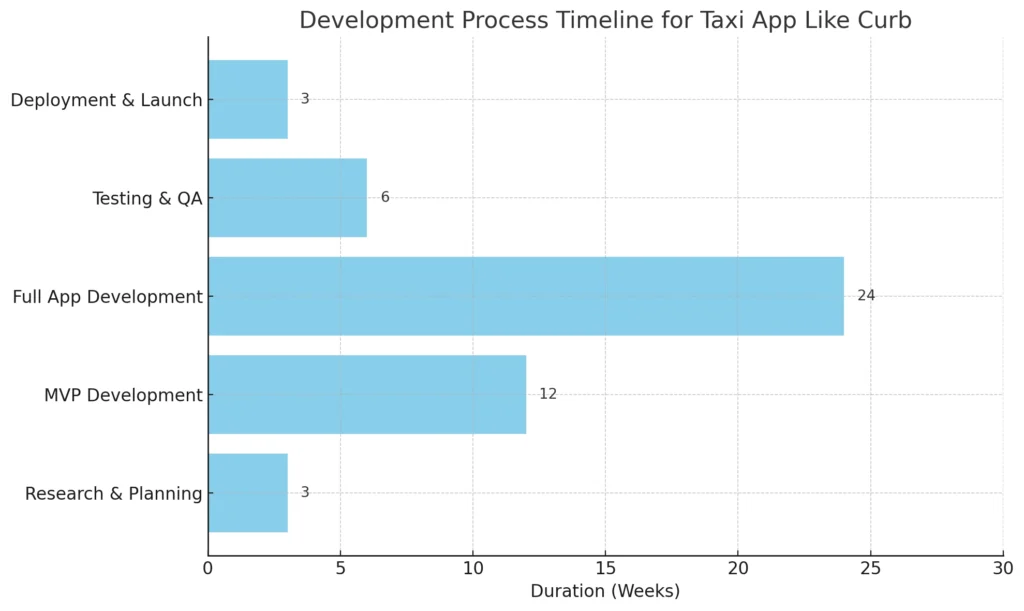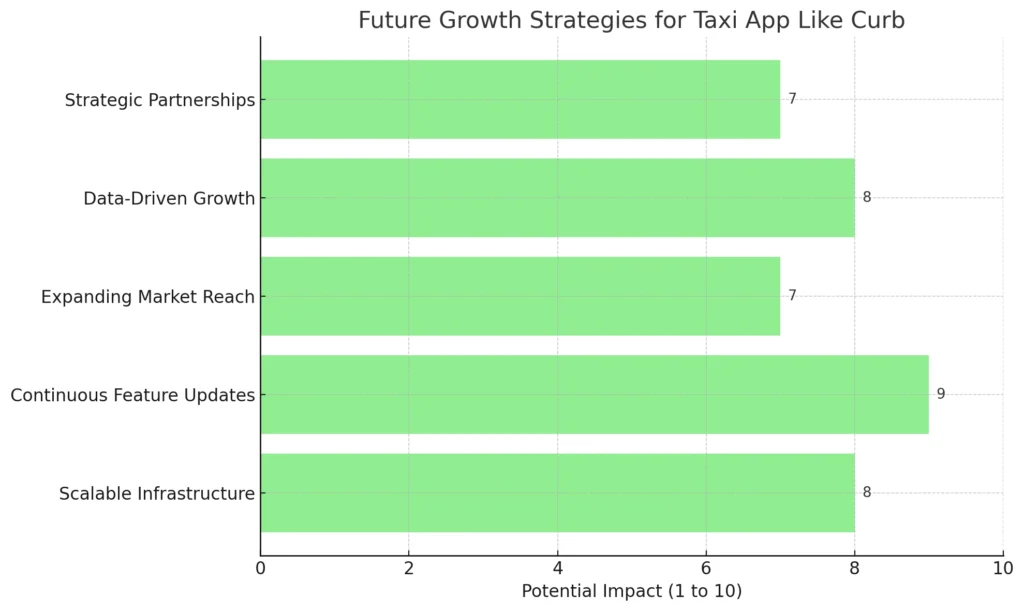The taxi industry has undergone a digital transformation with the rise of apps like Curb, blending traditional taxi services with the convenience of ride-hailing technology. In a highly competitive market, Curb differentiates itself by empowering professional taxi drivers and providing an intuitive platform where passengers can enjoy seamless booking, upfront pricing, and multiple payment options. As cities grow smarter, the need for efficient and reliable urban mobility solutions like Curb continues to rise, offering both passengers and drivers an alternative to ride-hailing giants.
Creating a Uber clone is not just about matching the features of Uber or Lyft but about tapping into the potential of hybrid models. These platforms integrate the reliability and professionalism of licensed drivers with the on-demand convenience of modern apps. With market forecasts estimating continued growth in the ride-hailing sector, building a Curb-style app presents an exciting opportunity for entrepreneurs looking to leverage both established taxi networks and innovative digital features
This guide walks you through every step needed to develop a taxi app like Curb, from planning and technology selection to design, development, and marketing. Whether you’re aiming to improve urban mobility or introduce unique features for differentiation, this comprehensive process ensures that your app can compete and thrive in today’s evolving transportation landscape.
What the App Is and What It Does
Curb is a taxi-hailing app that bridges the gap between traditional taxis and modern ride-hailing services. It provides passengers with a seamless way to book professional taxis via their smartphones. With Curb, users can either book rides on-demand or schedule them in advance, offering flexibility for commutes, airport transfers, and other transportation needs.
The app has grown popular for its upfront pricing feature, which eliminates surprises by showing the ride cost before booking—similar to ride-hailing giants like Uber and Lyft. However, it stands apart by partnering with licensed taxi drivers rather than independent contractors, ensuring that passengers travel with vetted, professional drivers who adhere to local regulations and safety standards.
Curb offers key features such as:
- Real-time GPS tracking for both drivers and passengers, ensuring transparency.
- In-app payments, including credit cards, contactless options, and tipping within the app.
- Wheelchair-accessible vehicles to serve passengers with mobility needs.
- Driver transparency and accountability, reducing biases and enhancing safety through documented interactions.
Why Build This App?
The taxi and ride-hailing industries are evolving rapidly, with new opportunities emerging for businesses that adopt hybrid models like Curb. Developing a taxi app like Curb can capitalize on multiple trends, including the demand for professional, safe transportation, increasing urbanization, and changing consumer preferences towards app-based mobility solutions. Unlike ride-hailing giants that rely on freelance drivers, a Curb-style app offers professional, insured drivers, which appeals to passengers who prioritize safety and reliability
With the global taxi market expected to reach $120.89 billion by 2027 and the US ride-hailing sector projected to grow to $96.9 billion by 2025, the potential for market growth is substantial
SpotnRides. This growth is fueled by factors such as the need for on-demand rides, the decline of private car ownership, and environmental initiatives promoting shared mobility.
A Curb-style app also taps into a niche opportunity: supporting existing taxi fleets with modern technology. Many traditional taxi operators struggle to compete with ride-hailing companies, but a dedicated app levels the playing field by offering digital convenience while maintaining the credibility of licensed drivers. This model not only supports professional drivers but also appeals to passengers dissatisfied with the gig economy model, offering a fair alternative to platforms like Uber and Lyft.
Building this app now allows businesses to secure a foothold in this growing market and contribute to the future of urban mobility by integrating local, professional drivers with modern app technology.
Also check : How to Build an App Like Via: Step-by-Step Guide for 2025
What Can I Do to Differentiate It?
In a market crowded with taxi and ride-hailing apps, standing out requires innovation, unique features, and enhanced user experience. To build a Curb-style app that captures users’ attention, it’s essential to focus on elements that differentiate it from the competition and provide value to both drivers and passengers.
- Advanced Loyalty Programs
- Introduce a rewards system for frequent users, such as discounts, cashback offers, or ride credits. This builds customer loyalty and keeps them engaged with your platform over time.
- Subscription Packages
- Offer subscription-based pricing plans with unlimited rides or capped monthly rates for passengers, similar to models used by some public transport networks. This creates a unique value proposition and attracts long-term users.
- AI-Driven Recommendations and Optimization
- Integrate AI-powered algorithms to suggest the quickest routes, preferred drivers, or personalized ride recommendations based on user history. AI tools also enhance the app’s efficiency by optimizing driver availability and minimizing wait times.
- Sustainability Focus
- Differentiate your app with eco-friendly initiatives. Partner with hybrid or electric vehicle fleets and promote environmentally conscious rides. Offering carbon-neutral ride options can appeal to passengers who prioritize sustainability.
- Enhanced User Safety and Transparency
- Provide real-time driver credentials (insurance, license) and introduce in-app safety features like an emergency button. Ensure transparency with upfront pricing and detailed ride history, setting your platform apart from competitors like Uber and Lyft.
- Visual Chart Suggestion:
- Comparison Chart: Showcase your app’s unique features and competitive edge over Uber, Lyft, and Curb.
Market Size, Growth, and Business Model
The global taxi and ride-hailing industry is thriving, with projections indicating significant growth in the coming years. The market is expected to reach $120.89 billion by 2027, driven by increased demand for convenient, on-demand transportation. In the United States alone, revenue from the ride-hailing sector is predicted to climb to $96.9 billion by 2025, underscoring the rising preference for app-based services among urban populations
Building a Curb-like app positions you to tap into this growing market, offering an alternative to both ride-hailing giants and traditional taxis. By leveraging professional drivers and advanced technology, a well-designed app can bridge the gap between trustworthy service and modern convenience, capturing a loyal customer base.
Business Model Overview
The business model for a Curb-style taxi app revolves around multiple revenue streams:
- Commission on Rides
- Earn a percentage of each fare from drivers, which forms the core revenue stream, similar to platforms like Uber and Curb.
- In-App Advertising
- Generate additional income by displaying ads to users during rides or in the app’s interface, including targeted promotions and offers.
- Subscription-Based Services
- Introduce subscription models for frequent users, providing exclusive discounts or perks.
- Corporate Partnerships
- Offer customized transportation solutions for corporate clients and government accounts, a strategy that Curb successfully employs to diversify its income sources.
| Revenue Stream | Description | Advantages Over Competitors |
|---|---|---|
| Commission on Rides | Earn a percentage from every completed ride. | Provides a stable income similar to Uber but with better margins for drivers. |
| In-App Advertising | Display targeted ads during rides or within the app interface. | Adds an additional revenue stream without increasing passenger fares. |
| Subscription Services | Offer exclusive perks for frequent users through monthly or yearly plans. | Builds customer loyalty and guarantees recurring revenue. |
| Corporate Partnerships | Provide transportation solutions for businesses and government accounts. | Diversifies income sources and strengthens long-term business relationships. |
Features of the App
To create a Curb-style app, it’s essential to integrate a set of core features that cater to both users and drivers while ensuring smooth management from the backend. The right mix of user-centric functionalities and operational tools makes a significant difference in the app’s usability and competitiveness in the market.
User-Side Features:
- Instant Booking and Scheduling: Users can either book rides on-demand or schedule them for later, adding flexibility to travel plans.
- Real-Time GPS Tracking: Allows passengers to track their taxi’s arrival and follow the ride’s progress.
- Multiple Payment Options: Supports card payments, digital wallets, and contactless transactions, ensuring convenience.
- Driver Ratings and Feedback: Provides transparency and helps maintain high service quality.
Driver-Side Features:
- Trip Management Tools: Drivers can view incoming ride requests, accept jobs, and manage trip history within the app.
- In-App Navigation: Integrated maps ensure optimal routes for timely pickups and drop-offs.
- Earnings Dashboard: Drivers can track their earnings and view payment history directly within the app.
Admin Features:
- Analytics Dashboard: Provides insights into app performance, ride statistics, and user behavior.
- Driver and User Management: Enables admins to onboard new drivers, manage profiles, and address customer complaints efficiently.
- Fare and Commission Control: Allows customization of ride fares and commission percentages as needed.
Technical Requirements
Creating a robust and scalable taxi-hailing app like Curb requires the right technology stack and infrastructure to ensure smooth operation and future scalability. Here’s an overview of the essential technical elements needed:
Backend and Frontend Technologies
- Backend: Use Node.js or Django to handle the server-side operations efficiently. These frameworks offer scalability and reliability for managing ride requests and user data.
- Frontend: Implement React Native or Flutter for cross-platform development, ensuring the app works seamlessly on both Android and iOS.
APIs and Third-Party Integrations
- Payment Gateways: Integrate platforms like Stripe or PayPal to offer secure, seamless transactions.
- Mapping Services: Use Google Maps API or Mapbox for real-time location tracking and navigation.
- Push Notifications: Implement Firebase Cloud Messaging (FCM) to send ride alerts and updates to users and drivers.
Cloud Infrastructure
- Host the backend on Amazon Web Services (AWS) or Google Cloud Platform (GCP) for scalability. Cloud hosting ensures the app can handle a growing user base without disruptions.
- Use Content Delivery Networks (CDNs) to ensure fast loading times, improving the app’s performance.
Security Measures
- Implement SSL encryption for secure data transmission.
- Store sensitive data like payment details using tokenization or encryption methods to protect users.
Recommended Technology Stack for a Curb-Style Taxi App
| Component | Technology/Service | Purpose |
|---|---|---|
| Backend Framework | Node.js, Django | Server-side logic to handle ride requests and manage data. |
| Frontend Framework | React Native, Flutter | Cross-platform development for Android and iOS. |
| Payment Gateway | Stripe, PayPal | Secure and seamless in-app transactions. |
| Mapping Services | Google Maps API, Mapbox | Real-time GPS tracking and navigation. |
| Push Notifications | Firebase Cloud Messaging (FCM) | Alerts and updates for users and drivers. |
| Cloud Hosting | AWS, Google Cloud Platform (GCP) | Scalable infrastructure for backend hosting. |
| Content Delivery Network (CDN) | Cloudflare, AWS CloudFront | Ensures fast loading times and performance. |
| Security Measures | SSL Encryption, Tokenization | Protects user data and transactions. |
Design and User Interface (UI/UX)
Design plays a crucial role in user retention and satisfaction, especially in taxi-hailing apps like Curb. A well-thought-out UI/UX ensures seamless interaction, encouraging users to return and recommend the app. Here are the essential design principles and elements to consider:
User Interface (UI): Focus on Simplicity
- Minimalist Design: Keep the interface simple with clear buttons and intuitive navigation. Users should be able to book a ride in just a few taps.
- Color Scheme: Choose colors that align with your brand while maintaining readability and accessibility for users with visual impairments.
- Iconography: Use universally recognized icons (like a car icon for booking or a map pin for location) to guide users without needing excessive text.
User Experience (UX): Ensure Seamless Flow
- Onboarding Experience: Provide a smooth sign-up process with social media login options to reduce friction. A brief tutorial on first use can help users understand the app’s features quickly.
- Real-Time Feedback: Display real-time ride updates, such as driver arrival time and route progress, to keep users informed and engaged.
- Personalization: Allow users to save favorite destinations and customize payment preferences for faster booking in future rides.
Wireframes and Prototypes for Testing
- Develop wireframes to visualize the user flow and identify potential pain points early. Prototypes allow for usability testing before the app’s final release, saving time and resources during development.
These design elements, when implemented effectively, can enhance user satisfaction and set your app apart from competitors by offering an easy, engaging, and reliable experience. A well-designed interface ensures not just user acquisition but also long-term loyalty.
Development Process
Creating a taxi app like Curb involves a structured development process to ensure smooth execution and timely delivery. Following a step-by-step roadmap helps transform ideas into a functional product while addressing technical challenges effectively.
Step 1: Research and Planning
- Define the app’s scope by identifying core features and user needs.
- Conduct market research to understand competitors and trends, aligning your app with user expectations.
- Create a project timeline and budget to track progress efficiently.
Step 2: Building the MVP (Minimum Viable Product)
- Develop a basic version of the app with essential features, such as booking, GPS tracking, and payment options.
- The MVP helps you test the app’s performance in real-world scenarios and gather feedback from initial users.
- Make iterative improvements based on user responses.
Step 3: Development and Integration
- Use the chosen technology stack (backend, frontend, and APIs) to build the complete product.
- Integrate third-party services like payment gateways and mapping tools to enhance functionality.
- Ensure cross-platform compatibility by testing both Android and iOS versions.
Step 4: Testing and Quality Assurance
- Conduct multiple rounds of QA testing to identify and fix bugs.
- Perform stress testing to ensure the app performs well under heavy traffic.
- Check all user flows, ensuring the app is intuitive and free of friction.
Step 5: Deployment and Launch
- Deploy the app to Google Play Store and Apple App Store.
- Monitor for any post-launch issues and address them promptly.

Cost Estimation and Timeframe
Building a taxi-hailing app like Curb involves several cost factors, including development, design, testing, and launch. The total budget and timeframe can vary depending on the project’s complexity, the team involved, and the location of the developers. Below is a realistic breakdown of the cost and time estimates:
Cost Breakdown
- Design Phase: Around $5,000 to $10,000 for UI/UX design, including wireframes and prototypes.
- Development: The core backend, frontend, and integrations may cost between $40,000 and $80,000. Cross-platform apps often require additional work.
- Testing and Quality Assurance: Estimated at $5,000 to $15,000, ensuring bug-free and smooth performance.
- Deployment and Maintenance: Expect around $5,000 annually for updates, server costs, and post-launch improvements.
Timeframe Overview
- Planning and Research: 2 to 3 weeks
- MVP Development: 2 to 3 months
- Full App Development and Testing: 4 to 6 months
- Deployment and Launch: 2 to 3 weeks
When discussing the cost range for developing a taxi app, you can say: “The cost to develop a taxi app typically ranges from $50,000 to $100,000 based on various factors (Clutch)
Start Your Taxi App Development Today!
Ready to build your own taxi booking platform? We create
user-friendly, secure, and scalable apps tailored to your
vision. Let our experts turn your idea into reality .
Global Cost and Time vs. Miracuves Solutions for a Taxi App like Curb
| Task | Global Cost | Global Timeframe | Miracuves Solutions Cost | Miracuves Solutions Timeframe |
|---|---|---|---|---|
| Design Phase | $5,000 – $10,000 | 1 month | $500 | 1 day |
| MVP Development | $20,000 – $40,000 | 2 – 3 months | $2,000 | 3 days |
| Full App Development | $40,000 – $80,000 | 4 – 6 months | $5,000 | 1 week |
| Testing & QA | $5,000 – $15,000 | 2 – 3 weeks | $500 | 1 day |
| Deployment & Launch | $5,000 annually | 2 – 3 weeks | $500 annually | 1 day |
Monetization Strategies
Monetizing a taxi-hailing app like Curb requires implementing multiple revenue streams to maintain profitability and provide users with valuable services. A diversified approach ensures sustainable growth while offering flexibility to adjust based on market trends and user behavior.
1. Commission on Rides
- The core revenue model involves charging a percentage of each fare. For every completed ride, the platform takes a small commission from the driver’s earnings, similar to Uber and Curb.
- This model ensures consistent revenue from daily operations.
2. In-App Advertising
- Display targeted advertisements to users while they wait for their rides or explore the app. These could include local promotions or partner offers.
- In-app ads are a great way to generate passive income without affecting the user experience.
3. Subscription Models
- Offer monthly or yearly subscription packages to frequent riders. Subscribers could enjoy perks such as discounted rides, priority bookings, or access to premium vehicles.
- Subscription models encourage loyalty and create a reliable revenue stream.
4. Corporate and Government Accounts
- Partner with corporate clients and government bodies to provide transportation solutions. This strategy is ideal for ensuring large-scale contracts, such as airport transfers or event transportation.
- Long-term contracts with organizations stabilize revenue and expand the app’s user base.
5. Surge Pricing and Dynamic Fares
- Implement dynamic pricing during high-demand periods, like rush hours or bad weather. This feature allows the platform to increase profitability while ensuring supply meets demand.
- Users appreciate upfront transparency on pricing, enhancing trust.
Launching and Marketing the App
Successfully launching a taxi-hailing app like Curb requires careful planning and strategic marketing to attract early users and build momentum. A well-executed launch ensures that both drivers and passengers have a positive experience from day one, setting the stage for long-term success.
Pre-Launch Preparation
- Beta Testing: Release a beta version of the app to a limited audience to identify bugs and gather feedback. This helps fine-tune the app before the full launch.
- Create Buzz: Build excitement through pre-launch campaigns on social media, collaborations with influencers, and targeted ads. Offering early-bird discounts or exclusive access can create anticipation among users.
- Driver Onboarding: Ensure that drivers are properly trained and equipped to use the app smoothly during the launch phase.
SEO and App Store Optimization (ASO)
- Optimize your app’s visibility by using relevant keywords and high-quality visuals in app store listings.
- Ensure that your app description highlights key features such as real-time tracking, secure payments, and upfront pricing.
- Collect positive reviews from beta testers to enhance your app’s credibility from the start.
Post-Launch Marketing Strategies
- Referral Programs: Encourage users to invite friends by offering ride discounts or free rides through referral incentives.
- Targeted Advertising: Use social media ads and Google ads to reach your ideal audience, focusing on urban commuters and frequent travelers.
- Influencer Collaborations: Partner with local influencers to promote the app and showcase its benefits, such as faster service and more professional drivers.
A well-planned launch ensures that drivers are available, users are engaged, and feedback loops are in place to address any issues early. Ongoing marketing efforts, such as referral incentives and advertising, help sustain growth beyond the initial launch phase. With strategic marketing, your app can gain traction quickly and carve out a significant space in the competitive ride-hailing market.
Legal and Regulatory Considerations
Ensuring legal compliance and regulatory adherence is crucial when building a taxi app like Curb. Transportation apps operate in a highly regulated environment, requiring careful attention to local, national, and international laws. Failure to comply could lead to fines, operational delays, or even service bans in certain regions.
1. Data Privacy and Security Regulations
- Compliance with GDPR or CCPA: If your app operates in regions like Europe or California, it must adhere to strict data privacy regulations.
- Implement encryption protocols to secure sensitive data, such as payment details and personal information.
2. Licensing and Permits for Drivers
- All drivers must be licensed and insured, with vehicles meeting the necessary safety standards.
- In some cities, ride-hailing apps require additional permits or certifications to operate legally.
3. Insurance Requirements
- Provide insurance coverage for drivers and passengers to ensure safety during trips. Coverage should include liability insurance and accident coverage for unforeseen events.
- Some jurisdictions also require apps to provide commercial insurance policies beyond the driver’s individual coverage.
4. Payment and Tax Compliance
- Payment gateways must follow regulatory guidelines to ensure secure transactions. This includes compliance with PCI DSS (Payment Card Industry Data Security Standard).
- Your app must track income and taxes for both the platform and drivers to remain compliant with local tax laws.
5. Anti-Discrimination and Accessibility Regulations
- Ensure your app includes features for accessible services, such as wheelchair-friendly vehicle options.
- Maintain non-discriminatory policies in driver behavior, ensuring that all passengers receive fair treatment, regardless of race, gender, or location.
When mentioning compliance with data privacy laws, you can say: “Ensure your app complies with data privacy regulations, such as GDPR (General Data Protection Regulation), to protect user information (source).
Future Growth and Scalability
Planning for future growth and scalability is essential to ensure your taxi-hailing app evolves with market demands and user expectations. As your app gains traction, it needs to be capable of handling more users, higher traffic volumes, and new features without compromising performance. Here’s how you can build a future-proof app:
1. Scalable Infrastructure
- Use cloud-based platforms such as AWS or Google Cloud to easily scale up server capacity as demand grows.
- Implement microservices architecture, allowing different parts of the app (like booking and payment modules) to operate independently, improving flexibility.
2. Continuous Feature Updates
- Introduce new features periodically based on user feedback and emerging technologies. This keeps the app fresh and aligned with the latest trends in the mobility industry.
- Example updates could include AI-powered ride matching or additional payment methods, like cryptocurrency.
3. Expanding Market Reach
- After establishing a foothold in local markets, consider expanding to other cities or countries. This requires attention to local regulations and user preferences but increases revenue opportunities.
- Develop multi-language and currency support to accommodate global users.
4. Data-Driven Growth
- Use analytics tools to monitor app usage, driver activity, and customer behavior. Insights from these metrics help identify areas for improvement and new growth opportunities.
- Predictive analytics can help manage driver availability based on peak hours, enhancing efficiency and customer satisfaction.
5. Strategic Partnerships
- Form alliances with public transportation systems, hotels, and airports to increase the app’s relevance. Collaborations with vehicle providers can also promote the use of electric cars, aligning with sustainability trends.

Why Trust Miracuves Solutions for Your Next Project?
When considering developing a taxi-hailing app like Curb, partnering with the right company is crucial for success. Miracuves Solutions stands out as a premier choice for several reasons:
1. Cost Efficiency
Miracuves Solutions offers a significant reduction in costs, providing services at up to 90% lower rates compared to traditional development firms. This allows entrepreneurs to allocate more resources towards marketing and scaling their businesses rather than burning through budgets during development.
2. Rapid Development
With a streamlined process, Miracuves Solutions can deliver projects up to 30 times faster than industry standards. Their experience and optimized workflows mean you can launch your app in a timely manner, capitalizing on market trends before your competitors do.
3. Expertise and Experience
The team at Miracuves Solutions consists of experts in mobile app development, UI/UX design, and backend technology. Their knowledge of the latest industry standards and technologies ensures that your app is not only functional but also innovative and user-friendly.
4. End-to-End Support
From initial planning and design to deployment and maintenance, Miracuves Solutions provides comprehensive support throughout the entire development lifecycle. This ensures that any issues are swiftly addressed and that your app remains updated with the latest features and security protocols.
5. Proven Track Record
With a portfolio of successful projects in the mobility sector, Miracuves Solutions has demonstrated its ability to meet and exceed client expectations. Their commitment to quality and client satisfaction is reflected in numerous positive testimonials from previous clients.
Choosing Miracuves Solutions for your taxi app development project not only sets you on the path to success but also offers peace of mind, knowing you are backed by a trusted partner in the industry. With their cost-effective, fast, and expert-driven approach, you can focus on building your business while they handle the technical details.
Conclusion
Building a taxi-hailing app like Curb represents a significant opportunity in a rapidly evolving transportation landscape. As consumers increasingly seek reliable, efficient, and professional services, an app that combines traditional taxi operations with modern technology is well-positioned to succeed. With the right features, robust technology, and effective marketing strategies, your app can carve out a niche in this competitive market.
Partnering with Miracuves Solutions amplifies your chances of success, offering cost-effective solutions and rapid development timelines. Their expertise ensures that your app not only meets industry standards but also exceeds user expectations in terms of usability and functionality.
By focusing on user needs, adhering to legal requirements, and continuously innovating, you can create a platform that not only serves passengers but also empowers drivers. With the potential for sustainable revenue through diverse monetization strategies, your taxi-hailing app can thrive and grow in the long term.
Now is the perfect time to take the plunge into the world of taxi app development. With Miracuves Solutions by your side, you’ll have the resources and support needed to turn your vision into reality and contribute to the future of urban mobility.
Looking for expert taxi app development?
Develop Your Taxi App with Experts ! Our team will help you create a seamless, secure, and efficient platform with all the essential features for both drivers and passengers.
FAQs
How much does it cost to build a taxi app like Curb?
The cost to develop a taxi app like Curb typically ranges from $50,000 to $100,000, depending on features, technology stack, and design complexity. Partnering with firms like Miracuves Solutions can significantly reduce costs.
How long does it take to develop an app similar to Curb?
The development timeline can vary, but generally, it takes 4 to 6 months to build a fully functional app, including planning, development, testing, and deployment.
What makes Curb different from Uber?
Curb focuses on partnering with professional taxi drivers, ensuring a reliable service. Unlike Uber, which uses freelance drivers, Curb provides a platform for licensed taxi operators, promoting safety and accountability.
What technology is needed to build a taxi-hailing app?
Essential technologies include a robust backend framework (like Node.js or Django), a user-friendly frontend framework (such as React Native), and integrations with payment gateways and mapping services for real-time tracking.
Can I customize a Curb-style app with unique features?
Absolutely! While you can develop a clone of the Curb app, integrating unique features like loyalty programs, AI-driven recommendations, or sustainability options can help differentiate your platform and enhance user experience.








